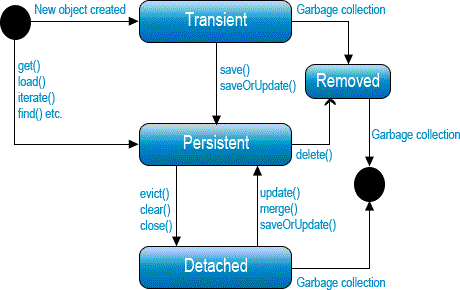Hibernate Life Cycle
This tutorial contains full description of Hibernate life cycle.
Hibernate Object Life Cycle :
Hibernate Life cycle shows how your persistent object managed. Hibernate is
ORM based java technology.
Hibernate saves, update and delete record in the database table regarding to
value of object as your persistent class is associated with the database table.
Hibernate object life cycle contains four states. These are -
- Transient
- Persistent
- Removed
- Detached
Diagram :

For clearing the the flow and concept of hibernate life cycle ,here we taking example of employee table. Employee.java is our persistent class.
Transient State :
When we create an object of our pojo class ,we can say it is in Transient
state.
By using new operator ,the object is instantiated and at that time it does not
enter into persistent but
into transient state. At this state it is not related to any database table. At
the time of Transient state
any modification does not affect database table. If no longer referenced by any
other object, it refer to garbage collection.
Example :
Employee employee=new Employee(); //employee is a transient object
Persistent State :
When you save your transient object it enter into persistent state.
Persistent instance has valid database
table row with a primary key identifier .It is instantiated by the persistent
manager when you call save().
If it is already exist you can retrieve it from the database. This is the state
where objects are saved to the database.
All the changes done in this state, are saved automatically.
You can made object persistent by calling against Hibernate session -
- session.save()
- session.update()
- session.saveOrUpdate()
- session.lock()
- session.merge()
Example :
Session session=Session.getCurrentSession();
Employee employee=new Employee() //transient state. Hibernate is unaware that it exist
session.saveOrUpdate(employee); //persistent state. Hibernate know the object and will save it to the database
employee.setName("Sonja"); //modification is saved automatically because the object is in the persistent state
session.getTransaction().commit(); //commit the transaction
Detached State :
In this state, the persistent object is still exist after closure of the
active session.
You can say detached object remains after completion of transaction .It is still
represents to the valid row in the database.
In detached state, changes done by detached objects are not saved to the
database.
you can not detach your persistent object explicitly. evict() method is used to
detach the object from session cache.
clear() ,close() methods of session can be used to detach the persistent object.
For returning in to the persistent state, you can reattach detached object by calling methods -
- update()
- merge()
- saveOrUpdate()
- lock() - It is reattached but not saved.
Example :
Session session1=Session.getCurrentSession();
Employee employee=Session1.get(Employee.class, 2); //retrieve employee having empId 2.employee return persistent object.
session1.close(); //transition is in detached state. Hibernate no longer manages the object.
employee.setName("Ron"); //Since it is in detached state so modification is ignored by Hibernate
Session session2=SessionFactory.getCurrentSession(); //reattach the object to an open session. Return persistent object and changes is saved to the database.
session2.update(employee);
session.getTransaction.commit(); //commit the transaction
Removed State :
When the persistent object is deleted from the database ,it is reached into
the removed state.
session.delete()
At this state java instance exist but any changes made to the object are not
saved to the database.
It is ignored by Hibernate and when it is out of scope, it is assigned to
garbage collection.
Example :
Session session=Session.getCurrentSession();
Employee employee=Session.get(Employee.class, 2); //retrieve employee having empId 2.employee return persistent object.
session.delete(employee); //transition is in removed state. database record is deleted by Hibernate and no longer manages the object.
employee.setName("Ron"); //Since it is in removed state so no modification done by Hibernate
session.getTransaction.commit(); //commit the transaction
